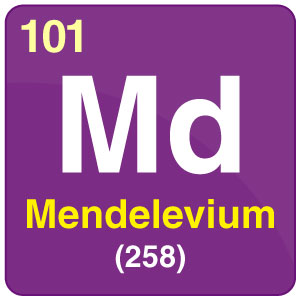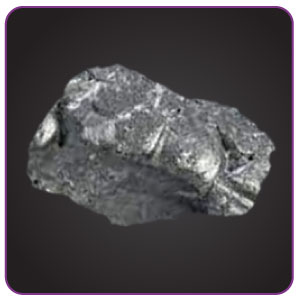Mendelevium

| Symbol | Md |
| Atomic Number | 101 |
| Atomic Mass | (258) g.mol -1 |
| Discovered by | G.T. Seaborg in 1965 |

Chemical Properties of Mendelevium
| Group | Actinides | Melting point | 827°C, 1521°F, 1100 K |
| Period | 7 | Boiling point | Unknown |
| Block | f | Density (g cm−3) | Unknown |
| Atomic number | 101 | Relative atomic mass | [258] |
| State at 20°C | Solid | Key isotopes | 258Md, 260Md |
| Electron configuration | [Rn] 5f13 7s2 | CAS number | 7440-11-1 |
| ChemSpider ID | 22385 | ChemSpider is a free chemical structure database. | |
What is Mendelevium?
- Mendelevium, a highly synthetic and a radioactive metal is placed in the periodic table with an atomic number of 101 and the symbol Md.
- The metal is produced in very minute amounts. The metal is named after the father of the periodic table in chemical elements, Dmitri Mendeleev. It was discovered in the year 1965 by G.T. Seaborg.
Uses of Mendelevium
- Since the metal is not produced in bulk amounts, it does not have any practical or economic applications.
- It is utilized for the purpose of scientific research and also to study the chemical properties of different elements and aqueous solutions by the use of the isotope 256Md.
Properties of Mendelevium
- It was obtained by bombarding einsteinium-253 with the helium ions. The metal has one most stable isotopes, mendelevium-258, which has a half-life of 51.5 days.
- It tends to decay into einsteinium-254 through the process of alpha decay or the process of spontaneous fission.
- Apart from naturally occurring isotope, the metal has around 16 synthetic isotopes whose mass numbers lie between 245 to 260.
- The metal exhibits similar characteristics to that of the elements of the actinide series, and it also possesses an oxidation state of III.
- Various experiments show that it also has a moderate oxidation state of II.
Facts about Mendelevium
- Mendelevium is said to be a highly radioactive metal known to be harmful when taken inside the body.
- Apart from this, it is not known to give out any impact on the surroundings are it is not produced on the earth’s crust.

Comments